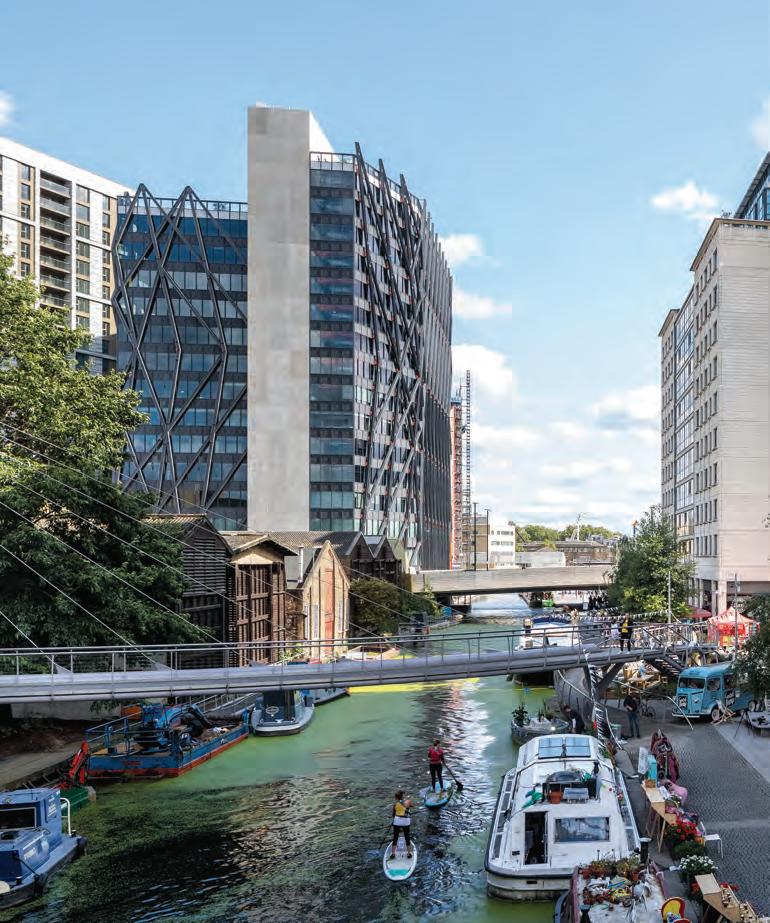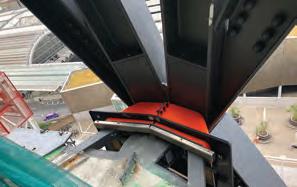
4 minute read
Brunel Building, London
The exoskeleton extends beyond roof level to create sheltered gardens
Produced by the BCSA and Steel for Life in association with Construction Manager
Advertisement
A NOD TO A FAMOUS ENGINEER
THE BRUNEL BUILDING HAS AN EXPOSED STEEL DESIGN AND IS NAMED IN HONOUR OF ISAMBARD KINGDOM BRUNEL, WHO BUILT THE ADJACENT PADDINGTON RAILWAY STATION
With his tall stovepipe hat, Isambard Kingdom Brunel is an instantly recognisable figure from history. As well as his headwear, the engineering innovator was famous for his bridges, tunnels and ships – and now an eye-catching commercial block, next to his Great Western Railway terminus in west London, has been named in his honour.
Known as the Brunel Building, the structure would have undoubtedly delighted the engineer with its exposed engineered steelwork and multiple connections.
“As well as offering recognition to Brunel, as his first-ever bridge was once located on the northern boundary of our site, the steel design has enabled us to express the structure in a contemporary way and create the desired clear internal spans,” explains Fletcher Priest Architects’ senior project architect Chris Radley.
The architectural brief was to create a landmark building which provided a high-quality, innovative, peoplecentred workspace and which would re-engage the site with the canal.
Within the structure, services are exposed to maximise flexibility and workspace volume. This logic is continued externally with an exoskeleton positioned outside the facade.
The exoskeleton structure extends beyond roof level to create glazed, wind-sheltered gardens on the 15th and 17th floor levels. It also shades the large expanses of glazing, affording scenic panoramic views across the west London skyline.
Changing station
A steel-framed link connects Waterloo’s former international terminal with the main station
Despite the bespoke nature of the building, a regular 6m floor beam spacing was used with precast lattice slabs set down into the web zone of the supporting steel plate girders. The services and structure are seamlessly integrated, enabling a more efficient use of the available structural depth and maximising floor-to-ceiling heights.
A semi-unitised curtain-wall cladding system with an insulated strong-back system provided a considerable amount of repetition, together with flexibility where required.
For the steelwork design, floor beams span directly from core wall out to the exoskeleton. One consequence of this is that the location of the floor beams on each level varies to meet the exoskeleton support. This means that beam location varies slightly on each floor and thus beam spans and service opening locations also vary. The project team used digital workflows to optimise and communicate plate thicknesses, weld sizes, connection designs, pre-cambers, movements, and fabrication and installation information.
Close collaboration between all parties allowed the various stiffness factors, tolerances and construction sequence impacts to be considered and individual pre-camber values agreed for each beam. This provided a challenge for the contractor and MEP subcontractors, which they solved, in part, by projecting the MEP subcontractor information onto the relevant ceilings while the operatives installed the required equipment and service runs.

In summary, the judges said this project shows how a proactive client working with a talented team can produce a commercial office building of the highest integrity. Expressed structural steelwork in the external frame and floor structures is dramatic and dynamic; all is detailed with great care and attention. A roof garden provides a welcome extension to the public domain. ●

Above: The curtainwall cladding of the facade is wrapped by the exoskeleton Below: Floor beams meet the exoskeleton support
Award: Brunel Building, London Architect: Fletcher Priest Architects Structural engineer: Arup
Steelwork contractor:
Severfield
Main contractor:
Laing O’Rourke Client: Derwent London

Commendation: Waterloo Station Roof Infill Architect: Aecom
Structural engineer:
Mott MacDonald
Steelwork contractor:
Bourne Group Ltd Main contractor: Wessex Capacity Alliance Client: Network Rail










